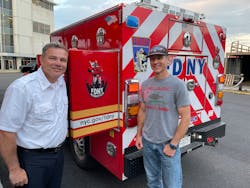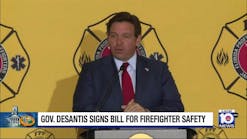Health & Wellness: Skin Cancer and Firefighters: How to Best Protect Ourselves
We all have heard in one way or another the statistics that show that firefighters are at an increased risk of developing and dying from cancer compared with that of the general population. Although the statistics are undeniably true, firefighters can take numerous simple actions to better manage their risk of occupational cancer.
May is melanoma and skin cancer awareness month, so although this column is timely, its discussion regarding the potential consequences of wearing dirty gear—in other words, skin cancer—and actions that you can take to manage the extent of your risk amounts to just plain, common sense.
Furthermore, knowing the signs and symptoms of melanoma is absolutely crucial, because early detection of the cancer is critical. The fact is, although skin cancer is one of the most commonly diagnosed cancers for firefighters, it also is among those that are the most preventable.
Background
The International Agency for Research on Cancer evaluated the carcinogenicity of occupational exposure as a firefighter. After thoroughly reviewing the available scientific literature, the agency classified occupational exposure as a firefighter as carcinogenic to humans (Group 1) on the basis of sufficient evidence for cancer in humans. The agency concluded that there is “sufficient” evidence in humans for mesothelioma and bladder cancer and that there is “limited” evidence in humans for colon, prostate and testicular cancers, melanoma and non-Hodgkin lymphoma.
The bottom line: There is a quantifiable risk for firefighters in relation to skin cancer, particularly melanoma.Melanoma
With millions of cases diagnosed each year, skin cancer is the most common cancer in the United States. It is the abnormal growth of skin cells. However, skin cancer is one of the most preventable cancers.
The three major types of skin cancer are basal cell carcinoma, squamous cell carcinoma and melanoma. Of the three, melanoma is the most serious type of skin cancer. Melanoma begins in the melanocytes, which are the cells that produce melatonin. This, in turn, gives you your skin color.
Most melanomas develop on skin that was exposed to sunlight. Typical areas of concern include the back, legs, arms and face. However, melanomas also can occur in areas that don’t receive much exposure ot the sun, such as the soles of the feet, the palms of the hands and fingernail beds.
To contribute to firefighters’ ability to identify characteristics of unusual moles that might indicate the presence of skin cancer, think of your ABCs—or, more specifically, your ABCDEs.
- A is for asymmetrical shape. Be cognizant of moles that have irregular shapes. An example of this is two very different-looking halves.
- B is for irregular border. Look for moles that have irregular, notched or scalloped borders, which are characteristics of melanomas.
- C is for changes in color. Look for growths that have numerous colors or an uneven distribution of color.
- D is for diameter. Look for new growth in a mole that’s larger than a quarter inch.
- E is for evolving. Be on the lookout for changes that occur over time. An example of this is a mole that increases in size or that changes color or shape. Also of significance: Moles might evolve to develop new signs and symptoms, such as new itchiness or bleeding.
Potential signs of melanoma:
- A large, brownish spot that has darker speckles
- A mole that changes in color, size or feel or that bleeds
- A small lesion that has an irregular border and portions that appear blue, blue-black, red, pink and white
- A painful lesion that itches or burns
- Dark lesions on the palms, soles, fingertips, toes or mucous membranes
Often, the first sign of melanoma is a change in an existing mole or a new, unusual-looking growth on the skin. It’s important to know that melanoma can occur on normal-looking skin.
It is important for firefighters to become familiar with their skin so that they’ll notice changes. Members should examine their skin often for new skin growths or changes. They should see a dermatologist regularly for a routine checkup.
Prevention
Numerous proven preventive measures reduce the risk of skin cancer. However, here are several additional considerations.
A consequence of wearing dirty gear might be skin cancer. Wearing dirty gear allows contaminants to be absorbed through the skin. This direct-contact exposure can lead to an increased cancer risk. Maintaining clean gear prevents harmful fireground contaminants (which contain carcinogens) from entering the body through the skin.
Properly wearing gear minimizes the skin’s exposure. The protective hood and helmet ear flaps both minimize contaminants that settle on the skin in the areas that they protect.
Following an exposure, use wipes to quickly remove as much of the soot and harmful contamination as you can. Research demonstrates a greater than 50 percent reduction of contaminants from the skin by taking this simple action. Remember, the sooner that contaminants are removed, the less that the contaminant exposure to the skin will be.
For a firefighter, showering as soon as possible following an exposure limits the time that contaminants are in contact with the skin. The shorter the time from exposure to showering, the shorter the exposure.
Particularly during the warmer months of the year, firefighters spend a great deal of time outdoors. This includes performing apparatus maintenance, training and, of course, operating at alarms. When performing apparatus maintenance, training and other nonemergency activities, position yourself in a shady area when possible, particularly when conducting these activities during the time of the day when the sun’s rays are strongest (between about 10 a.m. and 4 p.m.).
Even in winter or when the sky is cloudy, you still are exposed to the sun’s harmful rays. Remember, sun exposure that’s accumulated over time also might cause skin cancer.
Wear sunscreen all year round, even on cloudy days. Use a broad-spectrum sunscreen that has an SPF of at least 30 and reapply at regular intervals. As stated previously, the sun’s rays are harmful even in the winter and on cloudy days.
During times when you will operate outside for extended periods, it’s important to prevent unnecessary exposures. Wear protective clothing that covers your arms and legs. Hats also can be useful, particularly a large-brimmed hat, which provides more protection than a baseball cap does.
Mollie’s Fund and FDNY
In the summer of 2021, FDNY partnered with Mollie’s Fund to bring skin cancer awareness to incoming and veteran FDNY firefighters. The partnership included the recording of a training video for firefighters that features New York University dermatologist Dr. Elizabeth Hale. The video teaches awareness of skin cancer and how to identify its signs and symptoms and stresses the importance of sun safety and prevention.
In addition, Mollie’s Fund donated six sunscreen dispensers for the Randall’s Island Fire Academy. The organization also provided dispensers and sunscreen to the training facilities at FDNY EMS Training Academy Fort Totten Park, FDNY Rockaway Tactical and FDNY Staten Island Tactical.
Today, almost two years after the initial FDNY partnership, Mollie’s Fund has collaborated with the fire academies in New Jersey, Connecticut and Fort Worth, TX, to launch similar programs. Mollie’s Fund is in discussions with firefighter training programs from other states to support more firefighters.
Worth the effort
Remember, your future self will thank you for the simple actions that you take today to preserve your future health.

Frank Leeb
Frank Leeb is the managing director of the First Responder Center for Excellence. He previously served as a deputy assistant chief in FDNY, retiring in June 2024 after more than 31 years. During his tenure with FDNY, Leeb held several senior staff positions, including chief of the fire academy, chief of training and chief of safety. He also has been a member of the East Farmingdale, NY, Volunteer Fire Department since 1983. Leeb holds a bachelor's degree in fire service administration from SUNY Empire State and a master’s degree in security studies from the Naval Postgraduate School, Center for Homeland Defense and Security. He served as an advisory panel member for UL's Fire Safety Research Institute's "Study of Coordinated Fire Attack Utilizing Acquired Structures" and was the keynote speaker for Firehouse Expo in 2022 and FireFusion 2024. Leeb is the author of "Cornerstones of Leadership: On and Off the Fireground." He was a presenter at the 2022 and 2023 U.S. Fire Administrator Summit on Fire Prevention and Control. Leeb can be contacted at [email protected].







